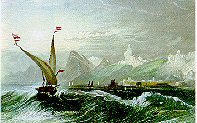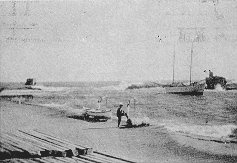

KYRENIAN SHIP OWNERS
As a columnist wrote in "RAYIAS" ("The Slave") in 1901 "there was a time when there were more than 30 ships, most of them with a capacity of over 20 tons, which served the needs of all markets in the Kyrenia district, sailing to the rich countries of the East with goods that brought life and pleasure to the people".
 Apart from sailing and other jobs, seamen even used to occupy themselves with loading, unloading, general painting and cleaning of the ship, cooking, fishing with a net or fishing line, cutting and sewing of sails and jibs, supervision and repair of the ship's rigging, maintenance of the ship's boat and carrying and dumping of waste materials into the sea.
Apart from sailing and other jobs, seamen even used to occupy themselves with loading, unloading, general painting and cleaning of the ship, cooking, fishing with a net or fishing line, cutting and sewing of sails and jibs, supervision and repair of the ship's rigging, maintenance of the ship's boat and carrying and dumping of waste materials into the sea.
The crew consisted of the skipper, who was often the owner of the ship, 3 - 4 sailors and also a recruit, a deck-hand.
Work day and night was carried out in shifts and was tiring and excruciating, when the ship was in port or on the high sea.
In bad weather, storms or even when it was dead calm, the men were always on the alert. When it was calm and the wind was not strong enough for the sails to belly out, the sailors had to tie up the ship behind a boat and row away while the boat was pulling the ship, until the wind became strong, which was hard and exhausting.
 The port of Kyrenia in 1931
The port of Kyrenia in 1931
The sailors took turns on the rudder. The helmsman had to stay awake and so did some of his mates. Something was then needed to keep the men oh the roster awake, for any emergency. And the captain always had this in mind when registering seamen: he looked for a seaman who, apart from other virtues, was also a good storyteller.
Sitting cross-legged on deck, close to the helmsman or the bow, the sailors listened to their yarnspinning colleague. His stories were hackneyed tales like "1001 Nights". Others had to do with aga (Turkish landlord) heroes, bandits, beautiful girls, journeys, sirens of the sea, dolphins, shipwrecks, horrid storms and drowning in the sea. There were also those of the wanderings of Ulysses, Sinbad the Sailor, Genevieve, Jean val Jean, Alexander the Great and similar ones.
My elder brothers and I as well as many children in the neigbourhood actually heard such stories from the mouth a well-known uncle of mine, captain Nikolios Hadjichristofi, who was a very good story-teller, at my home on winter nights when his ship "Antigone" was moored in Kyrenia harbour waiting for spring, when it would start its journeys towards the coast of Asia Minor facing Kyrenia.
From information I have gathered about this, seaborne story-tellers included sailor Hadjithomas Arestis, captain Demetris, the Turkish skipper Tilkis, captain Panayis Michaelides, Christodoulos Constantinides alias Pagona's, George Karayen, Yiannis Samiotis, Stephanos Halkitis, Pikliyiannis, Yiannis Kazinieris and Poupas Michaelides.
 Kyrenia's sailing ships were many and of different tonnage, varying from 20 to 120 tons. Some were traditional Greek wooden craft ("trechantiria"); there were also some barges. Every ship had its own boat whìch moved with sail and oars. One of these was "Antigone", whose boat and even cat bore the same name! They used to keep cats on the caique against mice and Asia Minor dogs for security.
Kyrenia's sailing ships were many and of different tonnage, varying from 20 to 120 tons. Some were traditional Greek wooden craft ("trechantiria"); there were also some barges. Every ship had its own boat whìch moved with sail and oars. One of these was "Antigone", whose boat and even cat bore the same name! They used to keep cats on the caique against mice and Asia Minor dogs for security.
From evìdence dating back to many years before 1800, which I have gathered, throughout the l9th century and during the first quarter of the 20th century, the port of Kyrenia played a significant part in conveying goods and passengers between Cyprus and the coastline of Asia Minor, the Dodecanese and even Alexandria.
Items that were exported on Kyrenian ships included textiles, locally woven cloth, woolen sheets, ready-made shoes and kerchiefs and even animals like donkeys and mules.
From the East they brought large quantities of beans, black-eyed beans, dry fruit, almonds, walnuts and hazelnuts. Food of animal origin included butter and cheese (such as white cheese). Seafood included octopuses and cuttlefish. They also carried large quantities of goatskins.
The larger ships carried large quantities of timber from the Taurus forests such as wood for mattocks, beams and logs, which were used all over Cyprus.
 When they carried goods or passengers they had to do the round of Cyprus, stopping especially in Limassol for wines and Famagusta for pots.
When they carried goods or passengers they had to do the round of Cyprus, stopping especially in Limassol for wines and Famagusta for pots.
On every ship there was a place for cooking. The kitchen was a wooden structure. Food supplies were called "company" and they made sure they had enough from the beginning before they started on their voyages, when the weather became calm. Essential food137 stuffs included baked ground wheat ("pourgouri"), oil, Cyprus white cheese ("halloumi"), biscuits, rusks, wine, marinated fish (with fish sauce), pulses of all sorts, pastry (macaroni, vermicelli) and onions. Their costume included heavy shepherd's overcoats, woolen underwear and raincoats.
Journeys started early in spring and continued throughout the summer and until the beginning of winter, when the strong north and south- easterly winds began to blow and ships had to remain moored in Kyrenia harbour. There were many jobs to be done then: repairing damages, changing broken sails or masts, calking and painting, so as to have a clean, tidy and quick ship for the new season.
Here are the names of some of Kyrenia's ships:
"Rigena","Digenis","St.Hilarion","Archangel","St.Andrew","Holy Trinity","The three brothers", "Augusta","Tilkis"(Turkish Cypriot),"Antigone", "Kounos tou Fitai","Aglaia". There was also a number of barges for loading carobs on steamships, which were anchored off the harbour.
Famous skippers included captain Demetris, Pikliyiannis, Yianriis Kazinieris, Christodoulos Constantinides, Stavros Constantinides alias Pagona's, captain Nikolios Hadjichristofi, Yiannis Vassiliou, Giorgos Vassiliou, Michalis Vassiliou Karakoules, Savvas Charalambous, Christos Diakou alias Korina's, captain Panayis Michaelides who studied navigation in Pireus and made many trips to Alexandria with "Rigena", Michalis Keleshis, Yiannis Samiotis, Yiannis Chiotis, Christofis Kestas, Giorgos Karayen, T. Skopelitis, Matheos Kariolou, Yiannis Samiotis, Petros Mitsides and Christodoulos Mitsides.
I remember from childhood that every year on September 6, the day of Archangel Michael, on the front mast of "Antigone", the ship which belonged to my uncle, they used to hang a colourful silk flag of Archangel Michael Panormitis, which was a souvenir from the great monastery of Panormos in Symi, where, according to tradition, Archangel Michael's icon was cast ashore by the waves.
1914, the year which saw the declaration of the First World War, was an important landmark in Kyrenia's commercial activity. On 5 November Great Britain declared the annexation of Cyprus to its dominions and Turkey joined the alliance with Germany. Thus Cyprus and Turkey found themselves in opposing camps and all commercial relations between them were broken off. This constituted a very severe blow to trade that was carried out with Kyrenian ships. As a result, the town's economy suffered tremendous damage.
N. CHIOTELLIS